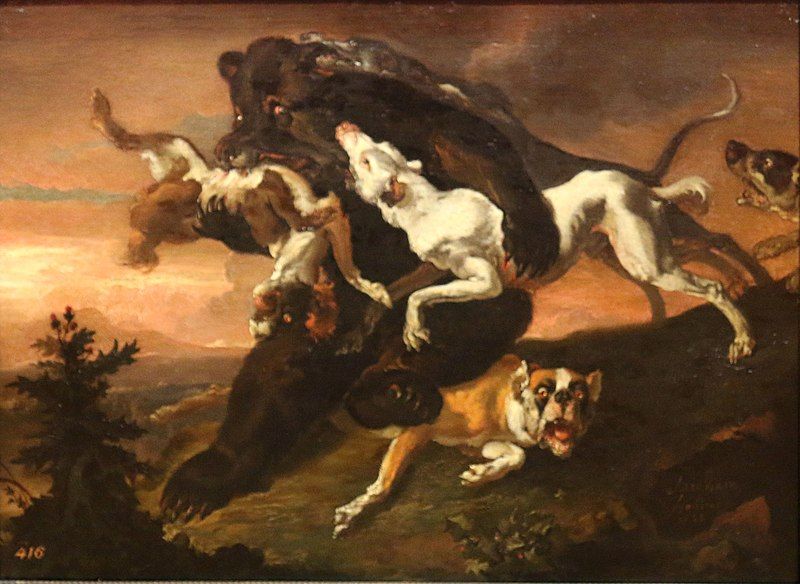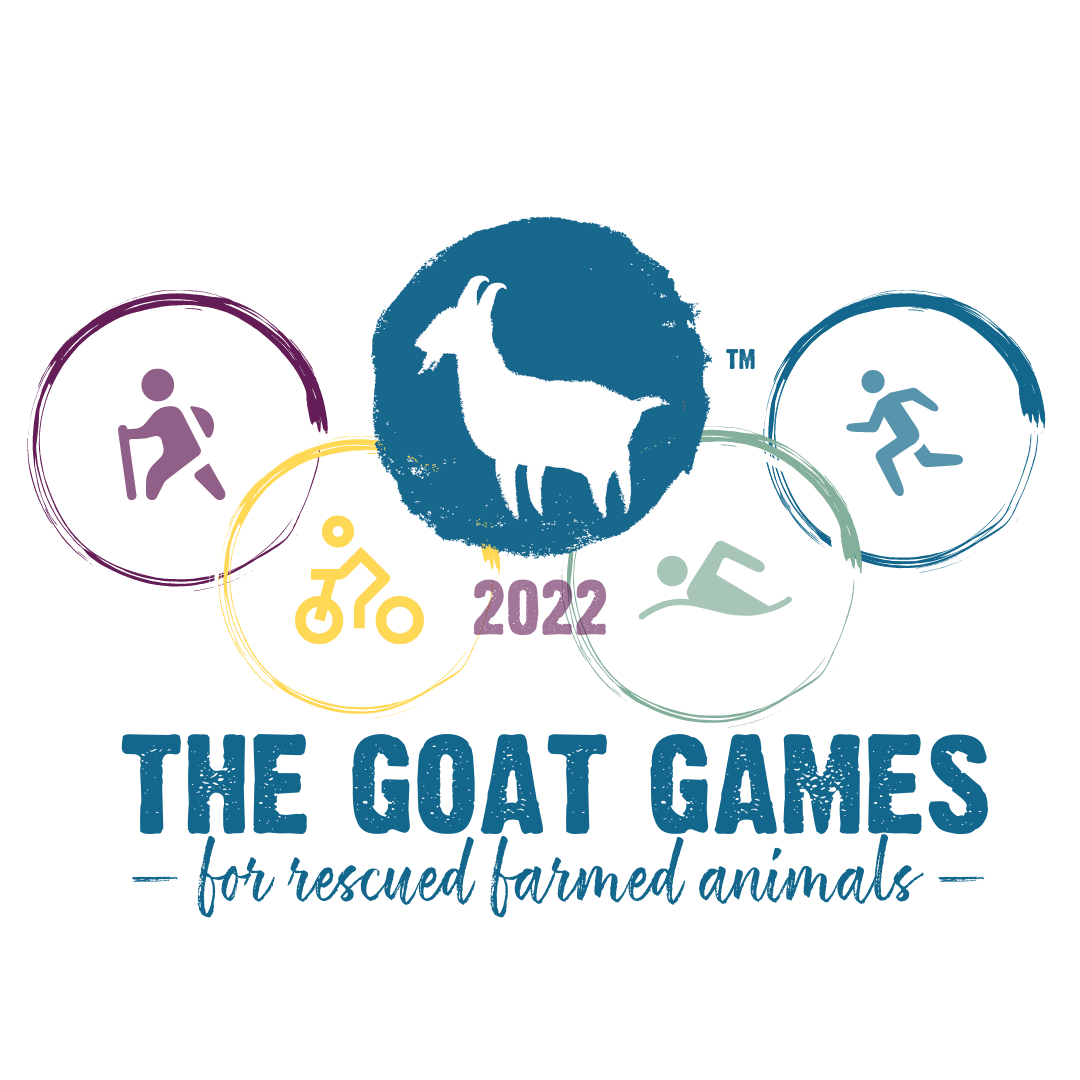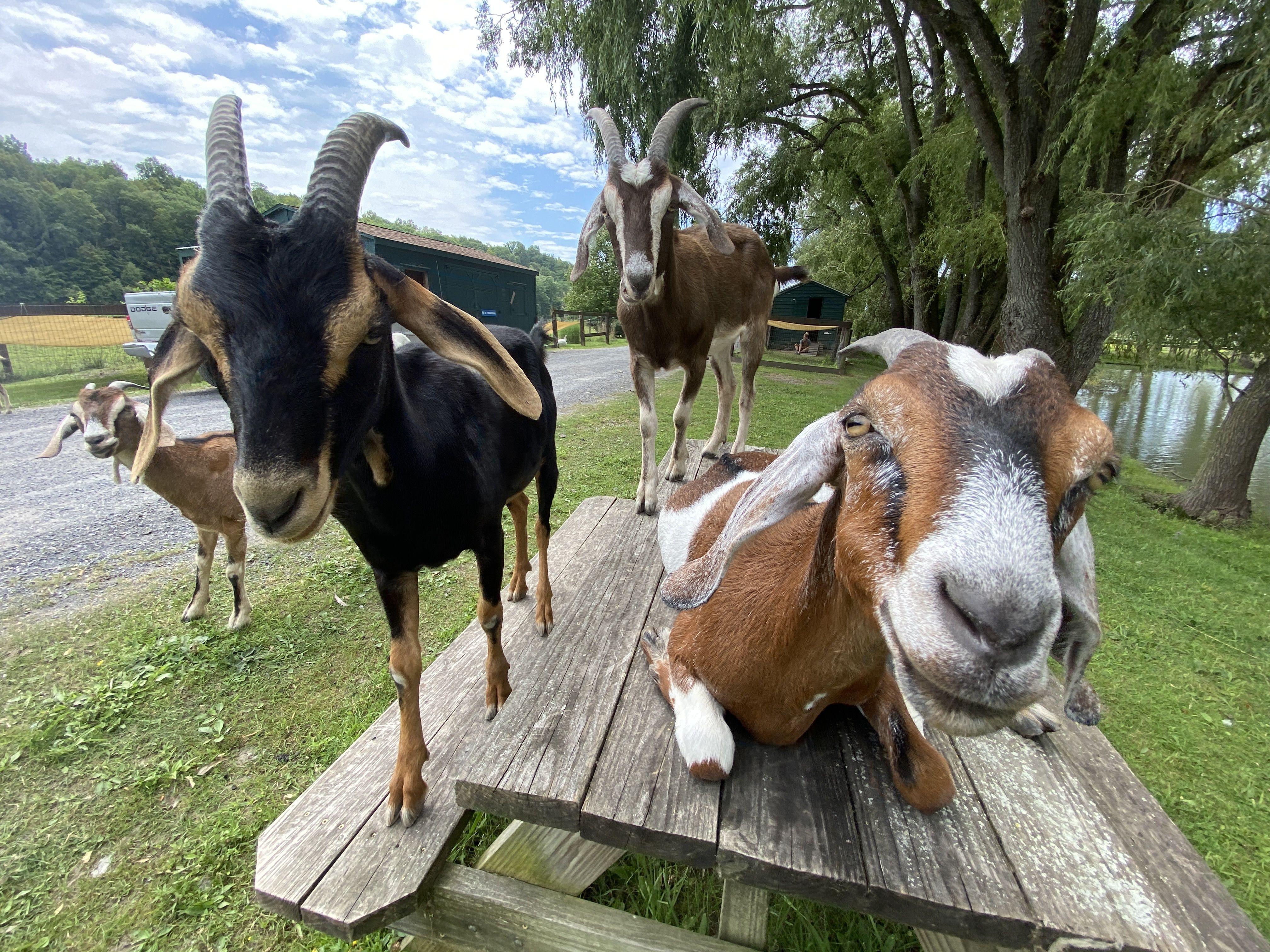
The Botstiber Institute for Wildlife Fertility Control's (BIWFC) 2022 Summer Newsletter is now available. In this edition you will learn about the recent 9th International Conference on Wildlife Fertility Control hosted by BIWFC in Colorado Springs, as well as other wildlife fertility control projects and issues.
The Botstiber Institute for Wildlife Fertility Control is a non-profit organization that aims to advance the use of effective, sustainable fertility control methods to mitigate human - wildlife conflicts and promote coexistence worldwide. BIWFC, established in 2016 as a partnership between the Dietrich W. Botstiber Foundation and The Humane Society of the United States, is headquartered in Media, PA with an additional office at the University of York in the United Kingdom. To learn more visit wildlifefertilitycontrol.org

“Have You Goat What It Takes?” Ask 14 Farmed Animal Sanctuaries
Competing in the 2022 Goat Games
Happening August 12-15, The Third Annual Goat Games Inspires Friendly Competition Among 14 Farmed Animal Sanctuaries Nationwide and Their Animal Champions
SAUGERTIES, N.Y. July 27, 2022 – Here we “goat” again! Catskill Animal Sanctuary (CAS), one of the world’s leading sanctuaries for farmed animals, is pleased to announce that it will host the third annual Goat Games. From August 12-15, CAS will be joined by 13 additional farmed animal sanctuaries located throughout the U.S. that will rally the support of animal lovers nationwide in support of their life-saving work. To register or make a donation, visit thegoatgames.org.
While the goats don’t actually compete, human athletes can sign up for an activity of their choosing – “whatever floats your goat!” – to raise awareness and funds for the sanctuary team of their choice. Participants can join this nationwide, virtual event from anywhere in the U.S.
“Covid did a number on us, as it did on nonprofits around the world,” said Kathy Stevens, Founder of Catskill Animal Sanctuary. “Funding plummeted, while the urgent needs of hundreds of animals remained the same. So in 2020, we created The Goat Games as a way for animal lovers to support the work of farm sanctuaries and the thousands of animals who call these special places home. We’re thrilled to host The Goat Games again to raise funds for farmed animals everywhere— and that need is more urgent than it’s ever been.”
Stevens explained that not only are sanctuaries “just digging out, in year three” of the pandemic, but they’re doing it at a time when the cost of everyday supplies is through the roof. “Grain cost is up. Hay cost is up. Medical supply costs are up. The cost of building materials is so high that a contractor suggested we not build anything.”
The Goat Games is a virtual event that challenges human participants to run, walk, bike, hike, or complete any activity of their choosing to raise money for a participating sanctuary. Each sanctuary has selected a farm animal as their team captain, and “athletes” will rally behind the farmed animal representing the sanctuary they want to support.
“We want to inspire animal lovers around the country to participate,” said Stevens. “Do whatever it is that you love – whether it’s running, reading, volunteering or binge-watching Netflix! Once folks pick their activity, they simply invite friends and family to support them as they raise funds for their favorite sanctuary.”
In its first year, Catskill Animal Sanctuary raised over $42,000. In 2021, CAS expanded The Games, inviting nine other farmed animal sanctuaries across the country to join, as a way to build camaraderie and increase national awareness of their life-saving work. The consortium raised over $217,000 to help rescued farmed animals. This year, they hope to increase that figure to $260,000.

The participating sanctuaries in the 2022 Goat Games include:
· Catskill Animal Sanctuary - the hosting Sanctuary (Saugerties, NY)
· Alaqua Animal Refuge (Freeport, FL)
· Farm Sanctuary (Watkins Glen, NY & Acton, CA)
· Farmaste Animal Sanctuary (Lindstrom, MN)
· Heartwood Haven (Wauna, WA)
· Indraloka Animal Sanctuary (Mehoopany, PA)
· Iowa Farm Sanctuary (Oxford, IA)
· Kindred Spirits Sanctuary (Citra, FL)
· Little Bear Sanctuary (Punta Gorda, FL)
· Piedmont Farm Animal Refuge (Pittsboro, NC)
· River’s Wish Animal Sanctuary (Spokane, WA),
· Safe Haven Rabbit Rescue (Clinton, NJ)
· Wildwood Farm Sanctuary (Newberg, OR)
· Yesahcan Sanctuary, Inc. (Arcadia, FL
Funds raised through donations and sponsorships will support the life-saving mission of each participating sanctuary. For more information on The Goat Games 2022 including registering and/or making a donation, visit thegoatgames.org.
About Catskill Animal Sanctuary
Founded in 2001, Catskill Animal Sanctuary is a non-profit, 150-acre refuge in New York's Hudson Valley. It is home to eleven species of rescued farmed animals with between 275 and 400 residents at any given time. In addition to direct animal aid, the Sanctuary offers on-site tours, a weekly podcast, an award-winning vegan cooking program, and educational programs that advocate veganism as the very best way to end animal suffering, improve human health, and heal an ailing planet.
Catskill Animal Sanctuary is the only U.S. farmed animal sanctuary with highest honors and accreditations from:
Charity Navigator (4 Stars), GuideStar (Platinum Rating), Better Business Bureau, and GFAS: Global Federation of Animal Sanctuaries
For more information, call (845) 336-8447 or go to www.casanctuary.org.
-End-
Media Contact Information:
Lauren Witt, Account Supervisor
(817) 721-5576
catskillanimalsanctuary@Interdependence.com
Hello Mojos
We may have been quiet over the last period, but
phew, have we been busy. MojoStreaming is growing more popular each month, with
a record 180,000 pages being visited last month. The areas that we have
been focusing on are firstly, live streaming from locations all over the world,
which can be seen at our live streaming page https://www.
bears, or lie in wait with us at an African waterhole to see what creature
ventures up for a drink.
The second area is our wildly (excuse the pun)
popular talk show, Mojo Talks. We have accumulated a host of must see talk
shows which can be seen at https://www.mojostreaming.
watching these fascinating talk shows;
Andrea Crosta who heads up, a cloak and dagger operation utilizing experienced spy and international security agency people to infiltrate the world of illegal Wildlife trade, the fourth biggest crime syndication after (and often allied to) the drug trade, human trafficking and immigrant smuggling, and the firearm trade.

One of our favorites out of a bunch of great
interviews…Interview with Ofir Drori, a very special human being, who attacks wildlife
crime at ground level. Hear the fascinating and touching story of how he became
involved in his current activities.

Another amazing human being is British Journalist Eduardo Gonsalves, who despite huge personal challenges, is at the
forefront of the battle to stop imports of Wildlife Trophies into Britain.
And a firm favorite amongst all the wonderful
stories – the interview with Chinedu Mogbo, a Nigerian who rescues and rehabilitates Wildlife and
educates local communities, teaching them to respect, love and live with
Wildlife.
These are just a few of the more than thirty
interviews that can be seen on MojoStreaming.com. Also, don’t forget our P.P.V.
movies, especially Land of the Free “In the Shadows” https://www.mojostreaming.
Lastly, please encourage friends, colleagues and
family to sign up at MojoStreaming so that we can further spread the word of
the beauty and wonder of nature – but also of the major challenges facing it.
The Mojo Team
IMPORTANT RULES WERE UPDATED AT 11:36 AM EST ON AUGUST 15, 2022
MOJOSTREAMING WILDLIFE VIDEO CONTEST (THE “CONTEST”) Mojo Streaming, the world’s premier Wildlife Streaming and Advocacy channel, is having a contest for our viewers globally to upload their most epic wildlife videos onto our site for a chance to win an Apple iPad and a fully paid lifetime subscription to MojoStreaming! Official Rules & Regulations (the “Rules”) By entering this Contest, you agree to abide by these Rules and the decisions of Mojo Streaming (“Mojo”), which are final and binding. 1. Who Can Enter This Contest is open to all animal lovers and wildlife enthusiasts. It’s open to anyone with exciting video footage about the wildlife they might have captured during their previous travels, safaris, or even from their backyard, which they would like to share with other wildlife enthusiasts to enjoy! Don’t be shy about your submissions-sometimes even the seemingly most straightforward videos can capture the hearts and minds of many. Similar to abstract art! The video must feature wildlife. It can be “cute”- such as baby animals or animals cuddling, “wild”- such as predators catching prey in the wild, “powerful”-such as animal migrations in dangerous terrain, “magnificent” or “beautiful”- there is so much incredible beauty and magnificence portrayed by animals living their lives in their natural state! 2. Contest Period the Contest runs from September 01, 2022, at 12:00:01 am (EST) to October 31, 2022, at 11:59:59 pm (EST) (the “Contest Period”).
3. How to Enter No purchase is necessary to enter or win, but all contestants must create an account with Mojo by going to the MojoStreaming.com sign-in page. There is no limit to the number of videos contestants can upload. The Mojo team will review all videos sent to Mojo before being posted onto the Mojo portal. By participating in this contest, contestants consent for the videos to be posted on Mojo. As well, contestants explicitly acknowledge that the videos they submit to Mojo are original footage taken by the contestant and not “borrowed from the actual proprietor of the video without the proprietor’s consent. All submissions remain the property of the contestant, but the contestant gives Mojo the right to use the content for promotional purposes for now and into perpetuity. Mojo assumes no responsibility for any lost, late, misidentified, illegible, misdirected entries or other such problems with participation in this Contest. Proof of sending or submission will not be deemed proof of receipt by Mojo. Use or attempted multiple identities, email addresses, and/or any automated system to enter or otherwise participate in the Contest is prohibited and grounds for disqualification. Any costs or expenses incurred by entrants in participating in the Contest, including data rates if the entrant enters the Contest using a mobile device, are the responsibility of the entrants. Regular internet access and device usage charges imposed by your online service provider will apply.
Follow these simple rules:
You must sign-up and load your contest video during September 2022.
1. Sign up: https://www.mojostreaming.com/signup 2. Complete profile 3. Upload video during September 2022 4. Complete questions: title, description, tags, choose channel September Video Contest. Your video will be found under this channel beginning October 1, 2022, once MojoStreaming approves it. You will then promote your video URL link or through the share button during October 2022. Your goal is to receive the most likes during October. 4. Prizes An iPad pro prize is available to be won through this contest for the best video and a lifetime subscription to MojoStreaming.com chosen by a panel of judges. Prizes are non-transferable and must be accepted as awarded. Mojo reserves the right to substitute the Prize in whole or in part if all or any of the components are unavailable with another prize of equal or greater approximate value. If the winner cannot redeem their Prize due to reasons beyond the control of Mojo, its employees, representatives, agents, and all parties associated with this Contest, no compensation or substitution prize will be provided. Any costs or expenses incurred by winners in claiming or using their Prizes will be the responsibility of the winners.
5. Selection of Winners The first round of the top 12 videos with the most likes from the public: (People can mark a video like or dislike during October) and be updated on the MojoStreaming.com site on November 1, 2022 (in case of a tie with the same number of likes will be included therefore there could be more than 12 videos in the top picks. A panel of Mojo judges will judge these winning entries with the most likes, and the winner will be announced on November 14, 2022, at or about 12. pm (ET) at a live event to be broadcast on MojoStreaming.
The winner will be notified within forty-eight (48) hours by telephone or email (email will be sent from admin@mojostreaming.com) using the phone number or email address associated with the entrant and contacted by a Sponsor representative and given instructions on how to claim the Prize.
To be declared the Prize winner, in addition to complying with the other terms and conditions of these Rules, the selected entrant must respond to the notification within forty-eight (48) hours and provide a valid mailing address, phone number, and email address. The winner must also correctly answer, unaided, a time-limited wildlife-related skill-testing question to be administered by mail, email, or phone, as Mojo determines. The winner will be required to sign a release form confirming acceptance of the Prize was awarded and releasing Mojo and its affiliates from any liability relating to the Prize and return it to Mojo within seven (7) days from the date of receipt. By accepting the Prize, the winner consents to the use by Mojo of their name, address (city and province), photo, image, likeness, biographical information, voice, and/or any statements made by the winner regarding the Contest or Mojo for promotional, advertising, marketing, publicity and commercial purposes in any and all media now or hereafter devised, including but not limited to, any online announcements, worldwide in perpetuity, without additional compensation, notification, or permission, except where prohibited by law.
If a selected entrant fails to meet any of these Rules in Mojo’s sole discretion, or if a selected entrant can’t be reached or prize notification is returned as undeliverable, the entrant will be disqualified. The runner-up will be awarded the prize and will be subject to the same conditions and could be disqualified in the same manner.
6. General Rules By entering this Contest, entrants accept and agree to be bound by these Rules, including all eligibility requirements and the decisions of Mojo and the independent judging organization, if any, which are final and binding without the right of appeal on all matters relating to this Contest. Mojo reserves the right to disqualify all entrants who fail to comply with these Rules or make any misrepresentation relating to the Contest, drawing, and redemption of any Prize.
Suppose a dispute arises regarding who submitted an Entry. In that case, the Entry will be deemed to be submitted by the authorized account holder of the email account provided at the time of entry. An authorized account holder is the natural person assigned to an email address by an Internet access or online service provider, or other organization responsible for assigning email addresses for the domain associated with the submitted email address.
By participating, entrants release and hold harmless Mojo and its affiliates, and its and their directors, officers, employees, advertising and promotional agencies affiliated with this Contest, participating establishments, and any independent contest judges appointed by Mojo from any claims, actions, injury, loss, or damage of any kind, including, but not limited to, illness, personal injury or death, resulting, directly or indirectly, in whole or in part, from participating in this Contest or from the acceptance, possession, or use or misuse of the Prize or any portion thereof (including any travel/activity related thereto). This limitation of liability is a comprehensive limitation of liability that applies to all damages of any kind, including (without limitation) compensatory, direct, indirect, or consequential damages; loss of data, income, or profit; loss of property damage; and claims of third parties.
Mojo won’t be responsible for any failure of email during the Contest or for any problems or technical malfunction of a telephone network or lines, computer online systems, servers, access providers, computer equipment, software, failure of any email, online, or Internet entry to be received by Mojo. In addition, Mojo won’t be responsible for technical problems, traffic congestion on the Internet or at any website, or any combination thereof, including any injury or damage to an entrant's or any other person’s computer or property related to or resulting from playing or downloading any material in the Contest. Mojo reserves the right, at its sole discretion, to cancel, suspend, extend or modify this Contest without notice, obligation, or liability if, in Mojos’ opinion, there is any suspected or actual evidence of tampering with any portion of the Contest, or if virus, bugs, non-authorized human intervention, force majeure or other causes corrupt or impair the administration, security, fairness, or integrity and proper play of the Contest, or for any other reason in Mojo’s sole discretion. In such a case, Mojo may select the winner(s) from all eligible Entries received before and/or after (if appropriate) the action taken by Mojo. Any attempt to deliberately damage any website or undermine this Contest's legitimate operation may violate criminal and civil laws. Should such an attempt be made, Mojo reserves the right to seek remedies and damages to the fullest extent permitted by law. Entries are subject to verification and will be declared invalid if they are illegible, incomplete, mechanically reproduced, mutilated, forged, falsified, altered, or tampered with in any way, or otherwise not in compliance with these Rules.
Mojo won’t be responsible in any way for the use of, or bear any liability whatsoever in any way attributable to, the Prize awarded in this Contest or the events forming part of this Contest, including but not limited to typographical or other errors in the offer or administration of this Contest, these Rules, the selection and announcement of winners or the distribution of the Prize. Mojo and its affiliates and its and their officers, directors, partners, partnerships, principals, representatives, agents, licensees, successors, and assigns (i) make no warranty, guaranty, or representation of any kind concerning the Prize, (ii) disclaim any implied warranty or condition, and (iii) are not liable for injury, loss, or damage of any kind resulting from the acceptance, use or misuse of the Prize, travel-related thereto or otherwise from participation in this Contest. Suppose there is any discrepancy or inconsistency between these Rules and the terms or statements contained in any short-form Contest rules or advertising materials. In that case, the terms and conditions of these Rules shall prevail.
This Contest is subject to all applicable Canadian laws in the province of Ontario, where Mojo is registered. All issues and questions concerning the construction, validity, interpretation, and enforceability of these Rules, or the rights and obligations of entrant and Sponsor in connection with the Contest, will be governed by and construed following the substantive laws of the Province of Ontario without regard to Ontario conflicts of law principles. All entrants consent to the jurisdiction and venue of the Province of Ontario.
7. Privacy Mojo is committed to respecting the privacy rights of entrants. Mojo won’t sell any personal information collected for this Contest to third parties. Except as otherwise set forth here concerning the Prize winner, any personal information collected for this Contest will be collected, used, and disclosed by Mojo solely to manage and administer this Contest. By entering this Contest, the entrant consents to Mojo's collection, use, and disclosure of the entrant's personal information to manage and administer this Contest.
8. Winner Names To obtain the name of the Prize winner, available after November 21, 2022, any inquiries can be sent to admin@mojostreaming.com.